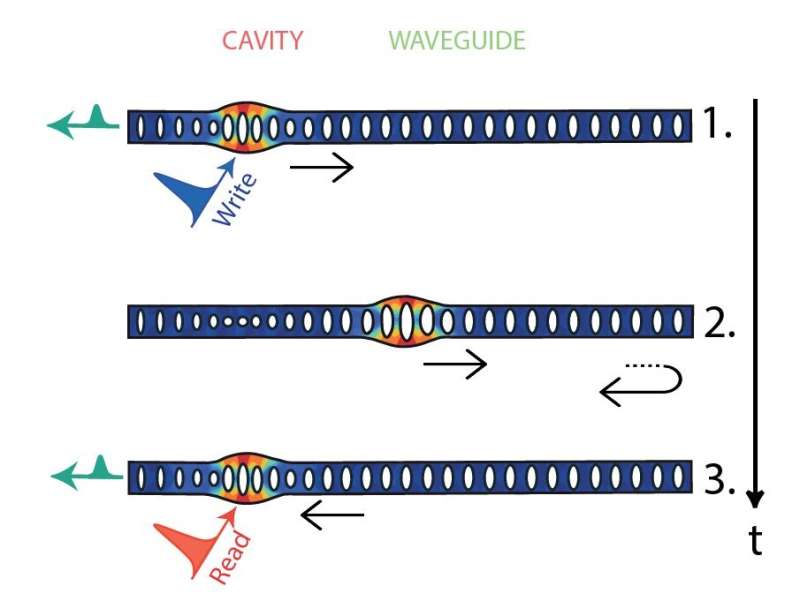June 24, 2022 feature
Controlling non-classical mechanical states in a phononic waveguide architecture

Most quantum computing technologies rely on the ability to produce, manipulate and detect non-classical states of light. Non-classical states are quantum states that cannot directly be produced using conventional sources of light, such as lamps and lasers, and can thus not be described by the theory of classical electromagnetism.
These unconventional states include squeezed states, entangled states and states with a negative Wigner function. The ability to similarly control the states of phononic systems, those involving acoustics and vibration, could open interesting possibilities for the development of new quantum technologies, including devices for quantum sensing and quantum information processing.
Researchers at Delft University of Technology (TU Delft)'s Kavli Institute of Nanoscience have recently introduced a strategy that could be used to achieve a high level of control over phononic waveguides. This strategy, outlined in a paper published in Nature Physics, could enable the use of phononic waveguides in quantum technology, similarly to how optical fibers and waveguides are used today.
Optical fibers and waveguides can be used to transmit quantum information encoded in optical photons. Over the past decades, they have been essential components for both quantum technology and classical communication technology.
"Realizing equivalent components to optical fibers and waveguides for mechanical excitations has the potential to revolutionize the nascent field of quantum acoustics and phononics," Simon Gröblacher, one of the researchers who carried out the study, told Phys.org. "Such low-loss phononic waveguides will not only allow to guide and transmit (quantum) information encoded in phonons over tens of centimeters on a chip, but will form the basis for full coherent control over traveling mechanical excitations."
The key objective of the recent work by Gröblacher and his colleagues was to devise a method to control non-classical mechanical states in a phononic waveguide with individual phonons in a suspended silicon microstructure. They ultimately aim at introducing a new toolbox to carry out experiments in the field of quantum acoustics, which would in turn allow physicists and engineers to interact with quantum systems in new ways.
"Acoustic waves are fundamentally different from the oscillation of single atoms or ions in traps, due to the associated large mass, their propagating character and the possibility to couple to a large variety of other quantum systems like quantum dots and superconducting qubits," Gröblacher, said. "Guiding single phonons is a crucial step towards realizing hybrid quantum devices and transfer quantum information over heterogeneous networks."
Over the past few years, Gröblacher's research group conducted numerous experiments focusing on phononic devices. In their previous studies, they were able to create, store and detect single phonons in photonic/phononic crystal devices, leveraging radiation-pressure optomechanical interactions.
As part of their recent study, they designed and realized the first phononic waveguide to produce non-classical traveling mechanical excitations.
"By fabricating the waveguide from thin film silicon we combine the waveguide with a source and detector for non-classical mechanical states and were able to verify the propagation of these quantum states in the waveguide," Gröblacher explained. "These acoustic waves at GHz frequencies are guided in a highly confined nanoscale geometry, with long lifetimes (up to several milliseconds), particularly at low temperatures, enabling the faithful transport of quantum states over centimeter distances on a chip."
In their experiments, Gröblacher and his colleagues showed that when propagating in their waveguide, the non-classical correlations emerging from phonons launched at different times are conserved. These non-classical correlations had a remarkable mechanical lifetime of approximately 100 μs,, which means that their system could theoretically be used to transmit single phonons over tens of centimeters, without significant energy losses.
The researchers also showed that their waveguide could be used to realize a phononic first-in-first-out (FIFO) quantum memory. In the future, such a quantum memory could have valuable applications in telecommunications and quantum acoustics.
More information: Amirparsa Zivari et al, Non-classical mechanical states guided in a phononic waveguide, Nature Physics (2022). DOI: 10.1038/s41567-022-01612-0
Journal information: Nature Physics
© 2022 Science X Network




















